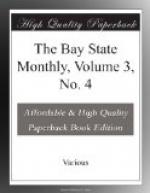General Scott rose from his sick-bed in New York, and hastened to Washington, on the 12th of December. On the 13th he had an interview with the President, in which he urged that three hundred men be sent to reinforce Major Anderson at Fort Moultrie. The President declined, on the ground, first, that Major Anderson was fully instructed what to do in case he should at any time see good reason to believe that there was any purpose to dispossess him of any of the forts; and, secondly, that at this time (December 13th) he—the President—believed that Anderson was in no danger of attack.
The President acted his own will in the matter. On the 15th General Cass tendered his resignation, and retired from official life, for the avowed reason that the President had refused to reinforce Anderson, and was negotiating with open and avowed traitors. Secretary Cobb had resigned a few days before. Black, the Attorney-General, was now made Secretary of State; Thomas, of Maryland, Secretary of the Treasury; and Edwin M. Stanton was appointed Attorney-General. The President believed, and undoubtedly honestly, that, by his concession to Floyd and the other conspirators, he had stayed the tide of disunion in the South. It now appears how quickly and unexpectedly he was undeceived. While these events were transpiring, a paper addressed “To our Constituents,” and urging “the organization of a Southern Confederacy,” was being circulated for signature through the two houses of Congress. It was signed by about one-half of the Senators and Representatives of North and South Carolina, Georgia, Florida, Alabama, Mississippi, Louisiana, Texas, and Arkansas, and bore the date, “Washington, December 15, 1860.” It is to be remembered as the official beginning of the subsequent Confederate States, just as Governor Gist’s October circular was the official beginning of South Carolina secession and rebellion.
On the 20th of December, South Carolina, as has been previously stated, passed its ordinance. The desire, several times already expressed, to hold possession of the forts in Charleston harbor now took the form of a demand. The State Convention appointed three Commissioners to proceed to Washington to “treat for the delivery of the forts, magazines, light-houses, and other real estate, for an apportionment of the public debt, for a division of all other property, and generally to negotiate about other measures and arrangements.” The Commissioners arrived in Washington on the 26th of December, and, by special appointment, were to meet the President at one o’clock on the following day. Before that hour arrived an unlooked-for event occurred.
III.
We must now turn back again. Major Anderson, it will be remembered, had been sent to Charleston by order of Lieutenant-General Scott, acting, of course, under orders of the Secretary of War. Major Anderson’s first letter, dated November 23d, was sent through the regular channels. It appears from the records[3] that, on the 28th of November, he was ordered by Secretary Floyd to address all future communications only to the Adjutant-General or direct to the Secretary of War. From this time forth, then, Major Anderson could communicate only with the conspirators against his government.




